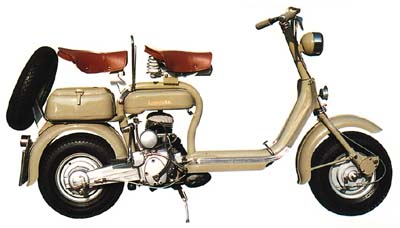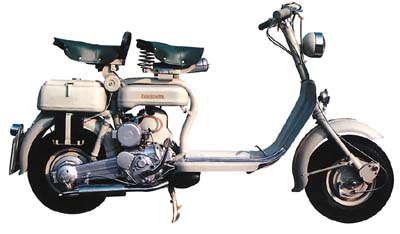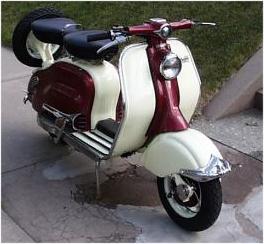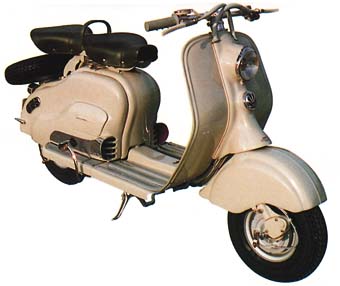Lambretta Model D & LD
Click HERE to view the PDF of the Production Facts & Figures
![]()
To complicate matters, with the advent of the D and LD range of scooters, quite a number of versions were made. Mostly now, they are named as Mark 1, 2 and 3, but if you counted models that were now manufactured around the world, the versions increased. The D model's differences were often slight, while the LD is more easily distinguished between the versions, due to the changes in body work. Because of the amount of undocumented changes mid production, the descriptions of both the D and LD models is by no means complete or exact!

The Model D
Model D 125 (Mark 1)
December 1951 saw Innocenti introduce the 125 D which sported a re-designed frame (of the tubular variety), with the petrol tank under the front seat, a butty box under the passenger seat and shortened leg shields. Bicycle style handlebars were fitted and underneath these was a large round headlamp.

The Model 'D' started life in December of 1951, when a 125cc (123cc) version was introduced. The 'D' was basically an update of the earlier 'C' with many improvements being made. The looks and frame work of the D pretty much stayed the same as the earlier C model, tubular in design, with the same layout for the fuel tank and rear tool box. The engine was a new design, it still had a cast iron cylinder and an air cooled aluminium cylinder head. The 3-speed gearbox was operated via a single teleflex gear cable. More power and speed was gained, power was up to 5bhp, with a claimed 47mph top speed. Fuel consumption was in the region of 140mpg from the new MA18 carburettor.
Finned drum brakes at the front and rear of the scooter provided its stopping power, the rear brake being rod operated. At the rear of the scooter, just above the number plate, a small round brake light was fitted. Unlike previous models the front fork tubes now enclosed the front suspension springs and the rear suspension was provided by means of a torsion bar. The 125 D was available in a choice of colour schemes; grey, beige and green. On either side of the petrol tank were Lambretta decals.
The D was offered with accessories such as a spare wheel holder and a pillion seat, but the best selling point of the D was the cheap prices (£108 in 1956 undercutting Vespa's) and servicing costs, helped make the 'D' and its sister the plusher LD very popular When production of the 125 D first series ceased in January 1953 a total of 69,000 125 D's had been built.
Model D 125 (Mark 2)
Innocenti introduced the Series II D 125 in April 1953, with some 53,641 machines being built during its production run. In essence it was very similar to the Series I Model D, utilising the same open style tubular frame, and the same air cooled 125cc engine, which produced 5hp at 4,600 rpm and gave a top speed of 47 mph
The rear brake was now cable operated as opposed to being rod operated like the Series I machine. The handlebars used on the Series II Model D were slightly different to those found on the Series I machine, though they were still like bicycle handlebars. The Series II 125 D was available in beige, grey or green and production of the second series ceased in October 1954.
Model D 150 (Mark 2)
The 125 D models were joined by a larger engine 150cc brother in October of 1954, the larger engine featured the cylinder and flywheel cowls similar to the Lusso models. Gone was the direct air cooling for the large engine machines, as was the single teleflex gear cable, being replaced by twin "push and pull" cables. The exhaust system of the 150 was redesigned and feature a rear chrome silencer exhaust, often being nicknamed the "coffee pot". For the first time a damper unit was fitted to the torsion bar suspension, to aid in the ride comfort. With the higher output of the 150cc engine unit cam a higher 55mph top speed, although Innocenti still quoted economy at around 140mpg.
Model D 125 (Mark 3)
The D 125 (III) was introduced by Innocenti in May 1955 and it is thought that it was brought into production as a special order. The main changes were two gear cables were fitted as per the second series 150 model. The D 125 (III) was available in three paint schemes these being green, beige or grey. By the end of its production run in 1958 a total of 500 D 125 (III)'s had been built.
Model D 150 (Mark 3)
Small changes from the second series 150D were the fittment of a battery for parking lights, horn and brake light. This was mounted on the kick start side, on a purpose built tray to the side of the tool box. The exhaust reverted to a single silencer unit, dispensing with the extra silencer as found on the second series. The leg shields sported a D150 badge in chrome, while the Lambretta name was still in the form of stickers on each side of the fuel tank.

The LD
The LD 125 (Mark 1)
The first version of the LD was not to dissimilar to the LC, launched in December 1951 the LD although as with the D model, improvements were made. Body changes were made, the main one being a raise in overall height to 960mm. The 123cc engine unit gained more power which was now 5hp @ 4,800 rpm. Carburation was increased in size, with the LC now using a Dell'Orto MA18B2 carburettor. The front suspension springs as with the D were now an enclosed by the fork tubes themselves, this was joined by the farmiliar torsion bar suspension but now with an added rear shock absorber unit. The LD, Lusso was of course the enclosed version of the D, featuring full length leg shields, side panels and rear passenger footboards. The LD had two port hole chrome trims in the side panel, and retained the opening hatch to turn on the fuel and cold start mechanism of the carburettor. At the end of its production in May 1953, 78,468 machines had been built, in a choice of either grey of beige for paint work.

The LD 125 (Mark 2)
In June 1953 the second version of LD 125 was introduced, with more changes. Gone were the port hole trims on the side panel, these were replaced by oval plastic grilles. The control cables and wires on the handlebars were now protected by grey plastic shrouding. The 125cc power unit retained its top speed of just under 50mph from the first series LD, but saw a change of carburettor, still a Dell'Orto MA18, but now a B3 model. Colour options were for the first time available in two tone (although this depended on which market the scooter was sold into) with either a grey of beige main body work and a choice of green, blue or red for the side panels. The 125 Version now featured a shield red and gold badge with the letters LD on the leg shields, and an optional speedo unit was housed in a purpose built miniature leg shield box. Although when specified and fitted, the cable for the speedo drive ran up the inside of the leg shields, showing the speedo was really an after thought, as up to now 125cc models that Innocenti had built were not required by law to have a speedometer.
The LDA 125 (Mark 2)
The LDA was essentially an LD, but with electric start, although this model switched to a Dell'Orto MA18 B4 carburettor. The electric start was run from a 6 volt battery housed under the left hand side panel. The starter unit itself was a seperate unit, which was bolted onto the front of a modified clutch cover, held by two 5mm allen screws. To start the scooter, you would engage neutral by using an ivory lever on the handlebars, this then engaged the start motor and turned the engine over. Once the engine had "fired up" a free wheel device disengaged the start unit. The battery as well as power the start motor, also provided power for the lights and horn. The LDA had a choice of two colours, either grey or beige, and a total of 8,694 were built.
The LD 150 (Mark 2)
As with the D model, and the LD gained a bigger engine brother, a 150cc version. The same power output as the D saw the top speed rise to 55mph. An an inside leg shield tool box was added as a standard feature, this toolbox also housed the speedometer, plus one other additional gauge. The second gauge was an optional extra, normally this was a time piece clock, and today these are quite rare and in themselves have been known to fetch as much as a complete machine! A tool box was added behind the rear seat, being accessible from outside the scooter, earlier model toolboxes were housed underneath the side panels. The 150cc version also gained a shield type badge on the leg shields as the 125 model, but this time it was in blue and white, with 150 on it. The LD 150 came in the same colour options as the 125 model, grey or green, then you could choose green, blue or red to the side panels if desired.
The LDA 150 (Mark 2)
The electric start version of the Mark 2 LD was now 12v volt, this was achieved by linking 2 6 volt batteries side by side. To accommodate the space they took up, a special "hump" was made at the rear of the frame, behind the rear seat. A newly designed and more reliable start motor was used, this fitted under the rear floorboards. Later models featured the epicycle kick start that became standard of third version LDs. Twin seats were offered as standard, and the colour choice was grey or blue main colour, with a second colour on the panels of red, blue, or green. A total of 2,020 examples had been built by the time production stopped in November 1956.
The LD 125 & 150 (Mark 3)
January 1957 saw the introduction of the third series of LD, in both 125 and 150cc engine sizes. The 125 and 150 versions retained the same engines from the predecessor, but with the addition of an epicyclical kick start. On the leg shields was a chrome model badge, depicting either LD125 or LD150 as appropriate, the horn cast Innocenti badge remained from previous models. The horn had now moved onto a purpose built casting on top of the handle bars, which as well as helping to tidy the cables and wires, but also housed a speedo unit. The rear of the scooter gained a more streamlined look, with a cast rear light unit bolted onto it, and between this and the rear seat was the toolbox door. Air induction was now taken to the rear of the frame through a rubber hose which helped reduce induction noise, and increase air flow, allowing the scooter to produce more revs. The 125 was available in grey, whilst the 150 version could be chose in grey or ivory. Second colours to the side panels were an option on the 150, these being green, maroon, red or blue. In the UK Lambretta concessionaires produced a variant called the Riviera. This model came as standard with a whole host of extras, these being front windshield, rear carrier with spare wheel, heel plates and extension boards. It was thought this model was produced to help make way for the incoming Li series, if this was true the marketing strategy although successful, also meant that Lambretta concessionaries were left with no scooters to sell whilst waiting for the new model. No Lambrettas were forthcoming from Italy, and so French built LDs were imported as a stop gap to help fulfill current orders.


